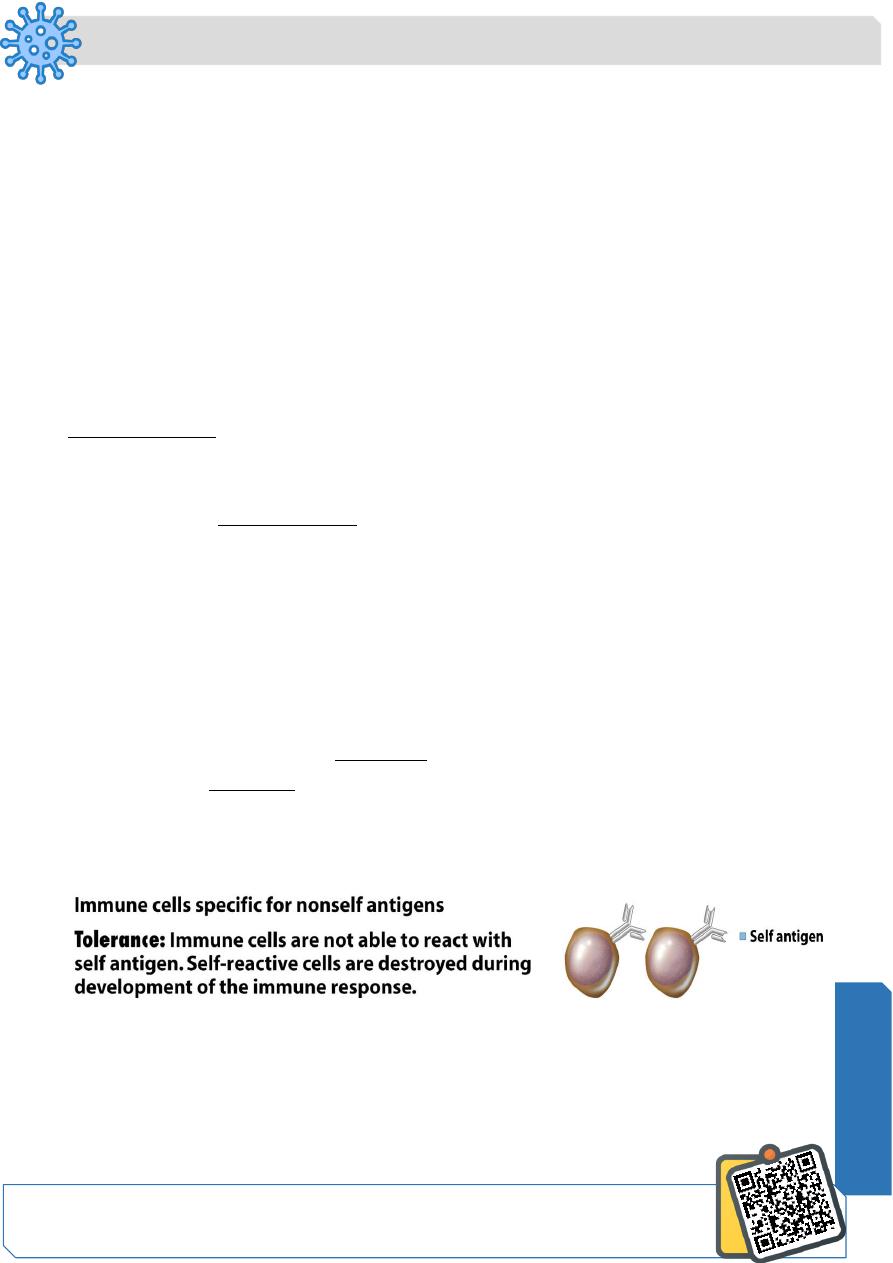
Microbiology
Notes…
1
Immunology Lecture.1
Immunology
It is the Science that deals with :
1. Body protective and defense mechanisms against diseases (infections and
tumours)
2. Clearance of dead cells and tissue repair
3. Vaccination
4. Allergy and hypersensitivity
5. Tissue transplantation and transplant rejection
6. Autoimmunity and immunodeficiency
Immunity
Original meaning
:Exemption from government taxes
In the context of immunology: Collective defense mechanisms against diseases
• The body system (cells, organs and molecules) responsible for the immunity is
called the immune system
Immune response
• The effort of the immune system in regards to any etiological agent.
• Usually against foreign immunogens ,useful (protection)
• Sometimes harmful
!!!!!!!!
(tissue damage)
Graft rejection
Autoimmunity against self immunogens
Hypersensitivity
Normally the immune system DOES NOT react against the body itself by a mechanism
which is named Tolerance (state of unresponsiveness to self antigen).
Break down of self antigen tolerance leads to (Auto-immunity).
The diseases that result from such a response are called (auto-immune diseases).
Self vs .Non-self
Antigens (Ags)
• Foreign substance
= Antigen
These antigens could be bacteria, viruses, fungi , parasites, cells tissues, chemicals,
drugs or food. The numbers of antigens in nature are up to trillions.
If able to produce immune response called immunogen or complete antigen.
If unable to initiate immune response alone called partial antigen.
N
eed S
om
e H
el
p?
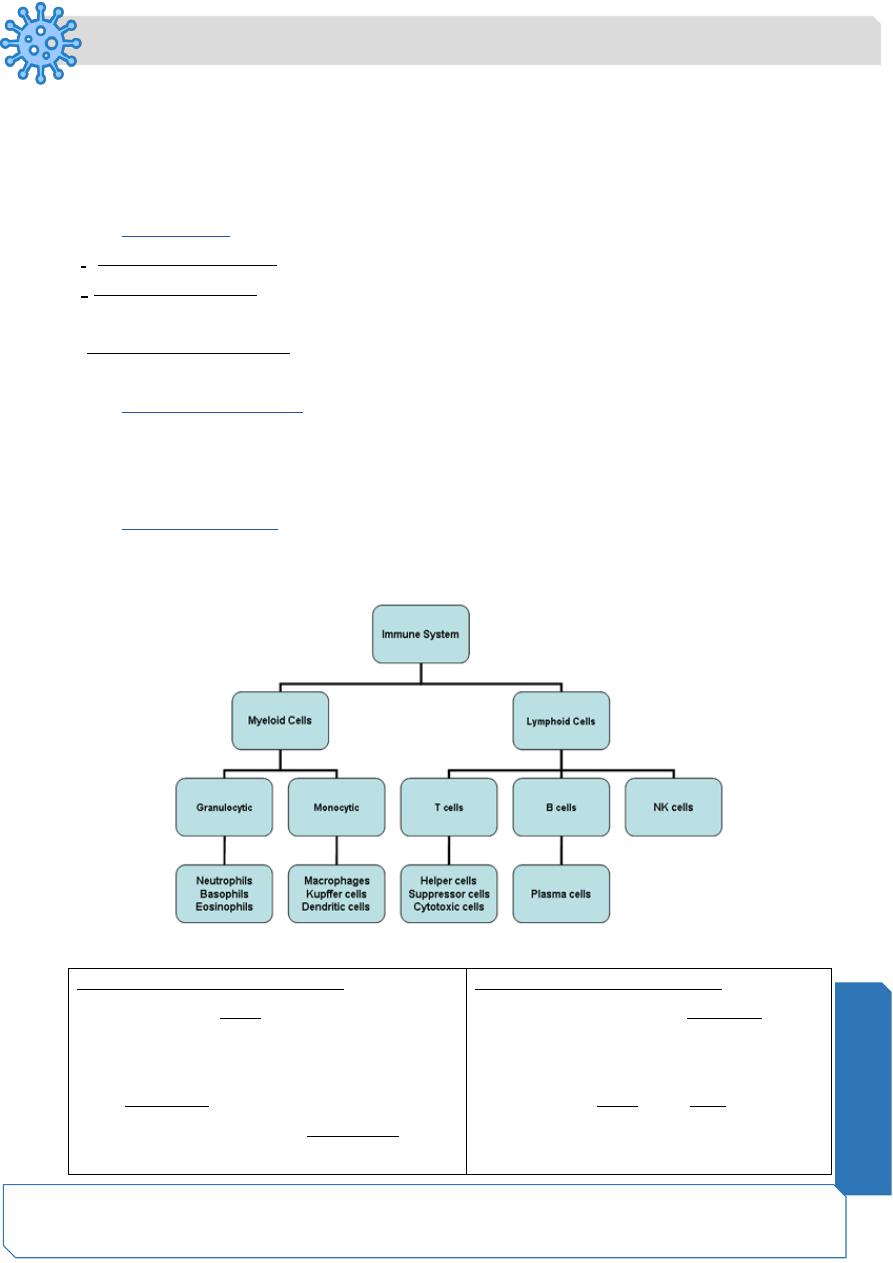
Microbiology
Notes…
2
All immunogens are antigenic but not all antigens are immunogenic.
Immune system does not react against the whole pathogen but parts of it
( Ags )and not
against the whole Ag but parts of it (chemical groups) called "epitopes "
.
Each Ag has variable number of epitopes.
Properties of Antigens
1. Foreignness
A )Autologous antigens : Self antigens and there will be no immune response.
B )Allogenic antigens : From the same species and there may be reaction, e.g.. Blood
transfusion, kidney transplant
C) Heterologous antigens : From different species .These antigens will be rejected and
there will be severe immune response
2. Chemical complexity
Most antigens contain at least one amino acid in their structures .More amino acid more
antigenicity.
Proteins > CHO > lipids
3. Molecular weight
More than 100,000 Dalton more immunogenic
Cells of the immune system
Types of Immunity
Innate (non-specific) immunity
-Present from birth in both invertebrates
and vertebrates
-Our First Line Of Defense
-Rapid starts within min-hours after
encountering pathogens
Adaptive (specific) immunity
Not present at birth but acquired during
life as immune system develops in
vertebrates only
-Late , starts days after first infection
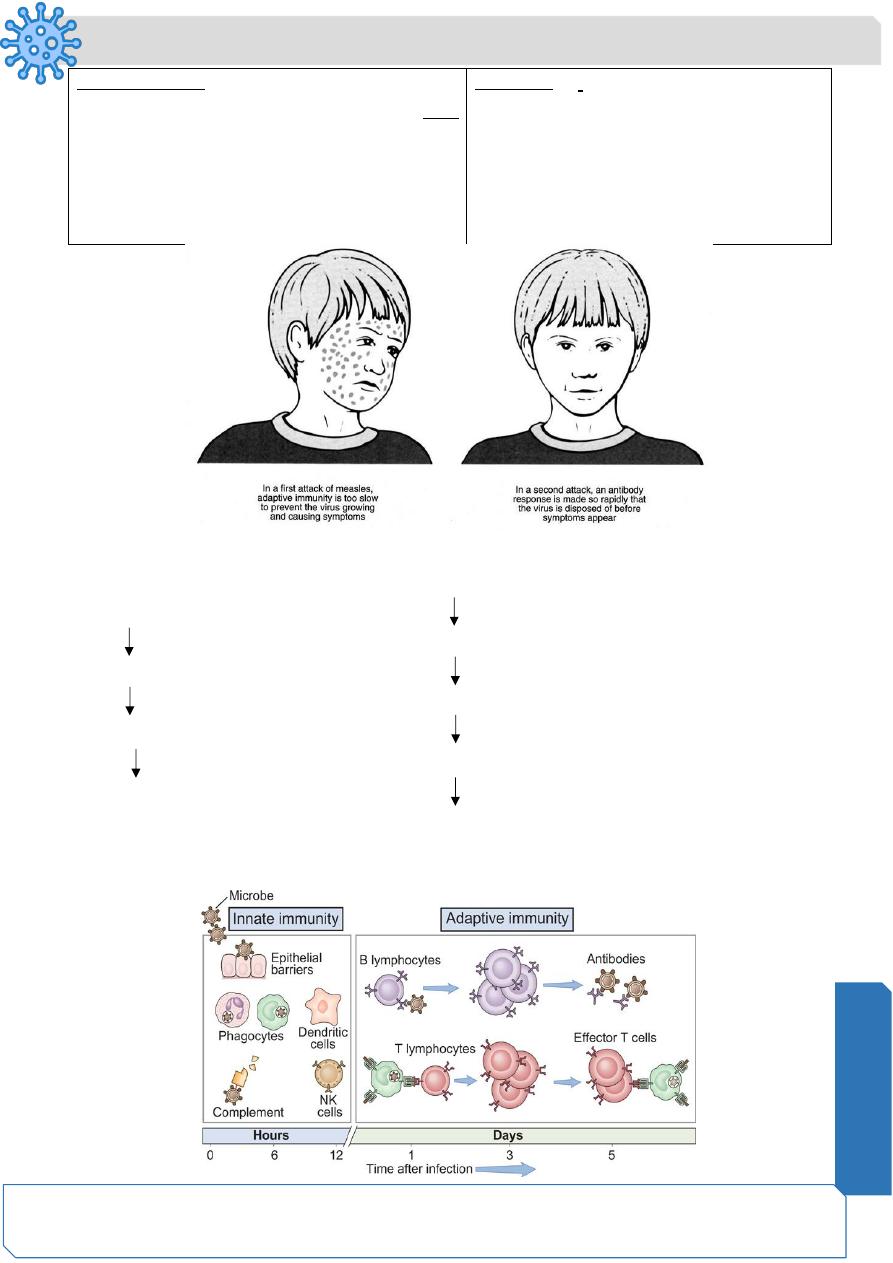
Microbiology
Notes…
3
- Not specific, recognizes generic microbial
structures and prevents almost ALL
pathogens from causing diseases;
-
Genetically encoded and produces
identical responses in all individuals,
-
NO memory cells
-Specific ,reacts specifically with
specific
immunological
molecules
called (antigens)
-
Acquired as an adaptive
response to exposure to antigens
-
Memory cells
“
Memory” in adaptive immunity
1st infection
Slow response
Pathogen proliferates
Disease Symptoms
2nd infection
Fast response
Pathogen being killed
No disease
No symptoms
Elements of Innate and Adaptive Immunity
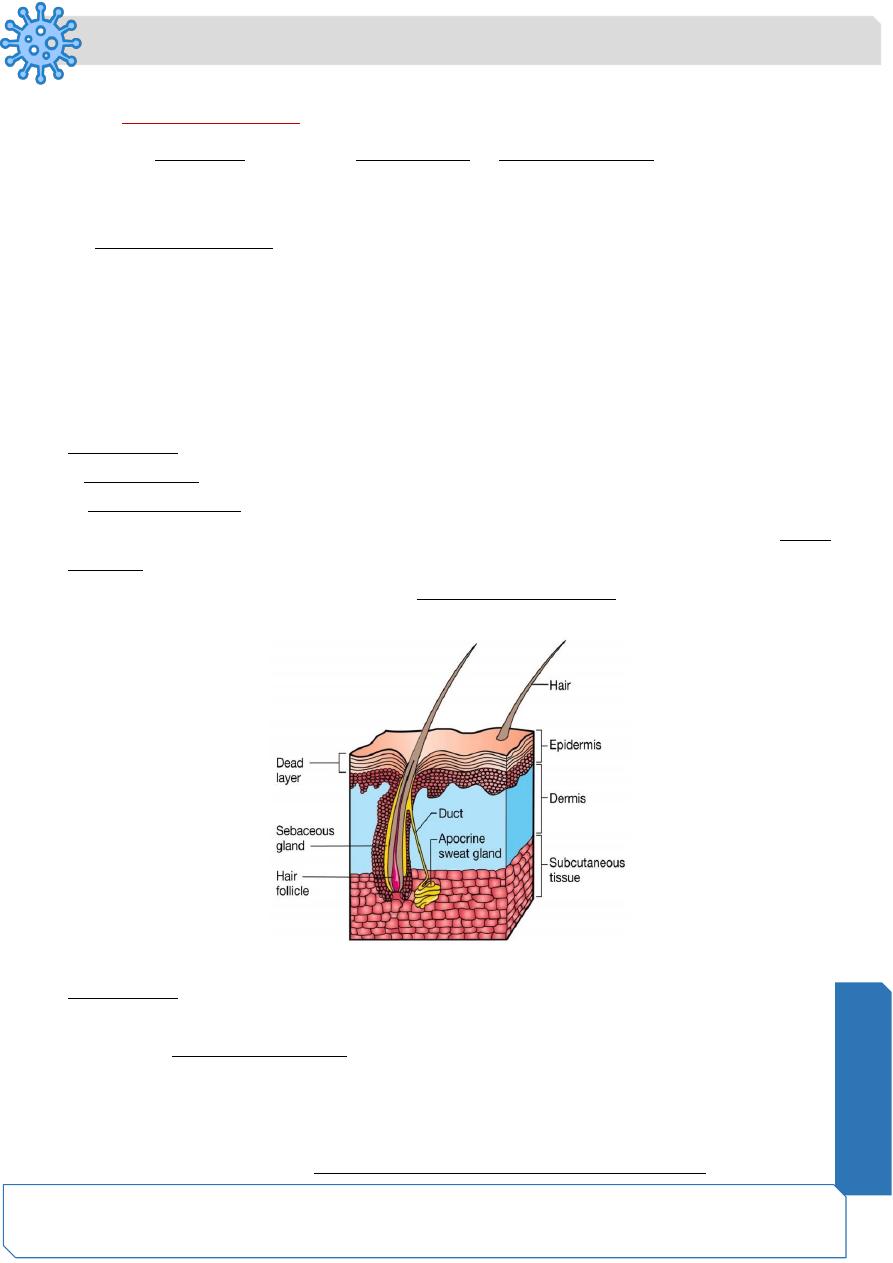
Microbiology
Notes…
4
Elements of Innate Imuunity
1. Epithelial Barriers
- Act as anatomical (physical) , physiological or chemical barriers
- Including the skin, mucous membranes, hair, cilia, sneezing, cough, and blinking of
the eyes. Also, mucous secretions trap many organisms.
- Physiologic Barriers
- Temperature - normal body temperature inhibits growth of most microorganisms.
- Elevated body temperature (fever) can have a direct effect on pathogenic
microorganisms.
- pH - low pH of stomach, skin, & vagina (inhibits microbial growth)
- Oxygen tension
Physical and Chemical Barriers-The Skin
Mechanisms
1. Skin integrity itself acts as anatomical barrier that prevents “bacterial colonization”.
2. Normal skin flora prevent potential pathogens from "Colonizing".
3. Sebaceous glands secrete fatty acids and lactic acid which lower the skin pH (acidic
pH ≈ 4-6).
4. Sweat glands in the skin secrete antimicrobial peptides e.g. (dermcidin) which
restrains the growth of various microbes on the skin.
Chemical and Physical Barriers-Mucosal membranes
Mechanisms
1. Ciliated epithelial cells lining the trachea remove microbes inhaled through the nose
and mouth (Mechanical removal).
Cilia push microbes upwards until they are caught in oral secretions and expectorated
or swallowed.
2. Mucus secreted by these cells prevent the microbes from associating
"Too closely" with the cells (Prevent attachment of microbes with tissues)
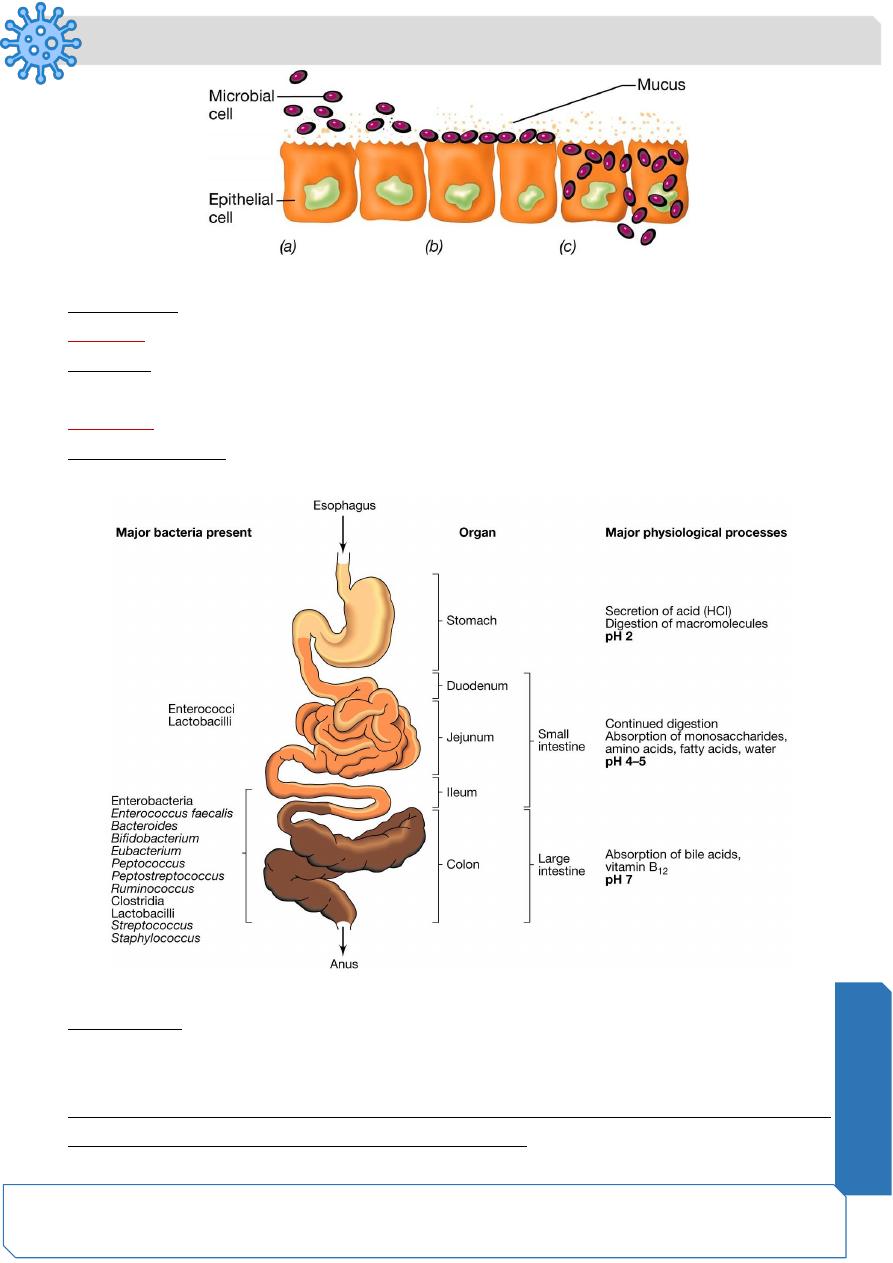
Microbiology
Notes…
5
Chemical and Physical Barriers-Normal flora of the Gastrointestinal Tract
Mechanisms
Stomach
Acidic pH of the stomach act as a physiological barrier that decreases the number of
viable pathogens reaching distal intestine.
Intestines
Normal GIT flora : Compete with pathogenic bacteria for nutrients and production of
enzymes or growth suppressor materials as Colicin (produced by enteric bacilli).
Chemical and Physical Barriers- Bactericidal agents
1. Lysozymes
Constantly bath the kidney the surface of the eye (tears) , female urogenital tract, and
saliva.
Lysozyme breaks the glycosidic bonds between the NAG and NAM that make up the
backbone of peptidoglycan—causing bacteria to lyse.
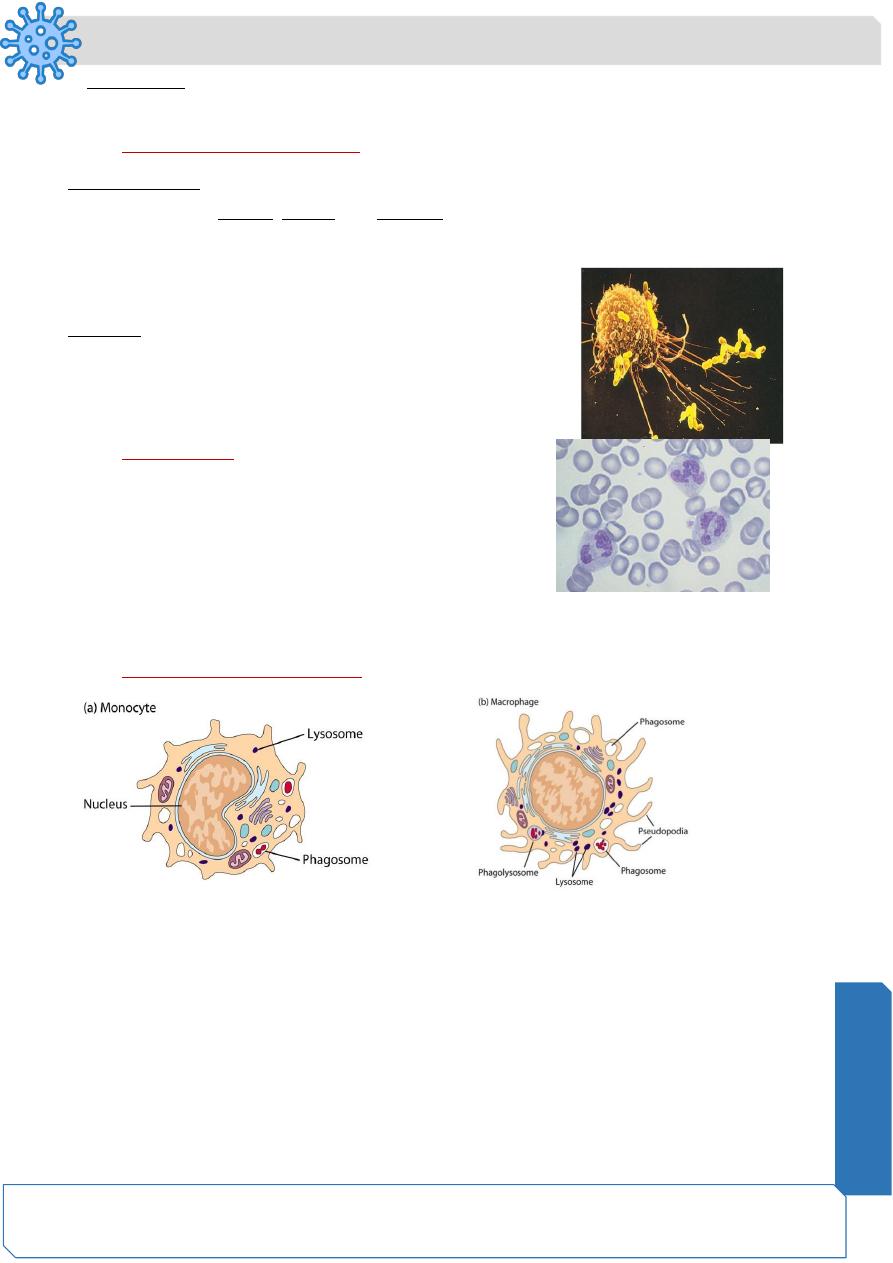
Microbiology
Notes…
6
2. beta-lysins : blood proteins bind to and disrupt the bacterial cytoplasmic membrane—
leads to leakage of the cytoplasmic constituents and bacterial cell death.
2. Phagocytes (eating cells)
Main functions:
- Cells that engulf, digest and destroy pathogens
- Also produce inflammatory molecules which regulate other components of the
immune system.
- Some of them present antigens to T cells
Include :
- Neutrophils (microphages)
- Eosinophils
- Monocytes/Macrophages
3. Neutrophils
• Present in blood (60-70% of WBCs)
• Multi-lobular nucleus
(PMN)
• Highly mobile phagocytes
• Short half life (6 – 12 hours)
• Acute inflammation
• Containing bacteria-killing enzymes
4. Monocytes/Macrophages
-
Blood (1-6 % of WBC)
-
Smaller
-
Tissues
-
5
-
10
times larger
-
More phagocytic activity
-
Named Based on Tissue They
Reside
Alveolar (lungs ,)Kupffer (liver),
Microglial (brain), Osteoclasts
(bone)

Microbiology
Notes…
7
How do Macrophages Identify Microbes?
They express a wide range of surface receptors that allow them to identify
microorganisms.
Pattern Recognition Receptors (PPR )
-Recognize pathogen associated molecular patterns (PAMP);
-Identify a class of microbes; ex., LPS, LTA, peptidoglycan, lipoarabinomannan, dsRNA,
mannose, b-glycans
-PAMP are often essential for microbe survival
Action Time
Immediate activation of effectors
Delays need for adaptive immunity
Phagocytosis
The process of phagocytosis include the following stages:
A) Activation of phagocytes
Under the influence of inflammatory mediators such as bacterial products (bacterial
proteins, capsules , LPS, peptidoglycans , teichoic acids, etc) , complement proteins and
inflammatory cytokines resting resident phagocytes are ACTIVATED. Activation of
phagocytes results in:
1. Increase production of endocytic PRR that recognize and bind to PAMPS
2. Increase metabolic and microbial activity of phagocytes by increasing their production
of ATPs, lysosomal enzymes , lethal oxidant , etc.
B) Chemotaxis of phagocytes
The activated phagocytes are ATTRACTED toward the site of inflammation under the
influence of inflammatory mediators such as bacterial products (bacterial proteins,
capsules , LPS, peptidoglycans , teichoic acids, etc.) , complement proteins (C3a, C5a)
and inflammatory cytokines such as IL-8, chemokines, fibrin split products , kinins and
phospholipids releases by injured host cells.
Note: Some microbes such as
influenza virus A
,
Mycobacterium tuberculosis
,
Neisseria
gonorrhea
and
Bordetella pertussis
known to block this step.
A) Inflammation
Infection or tissue injury stimulates mast cells, basophils and other cells to release
vasodilators. Vasodilation results in increase capillary permeability
• Resting phagocytes become activated by inflammatory mediators
C) Attachment and migration
• If epith. lining is breached by microbes, resident phagocytes are attracted (influx)
to the site by chemotactic substances as bacterial endotoxins (LPS), serum C5a,
IL-8, and leukotriene B4.
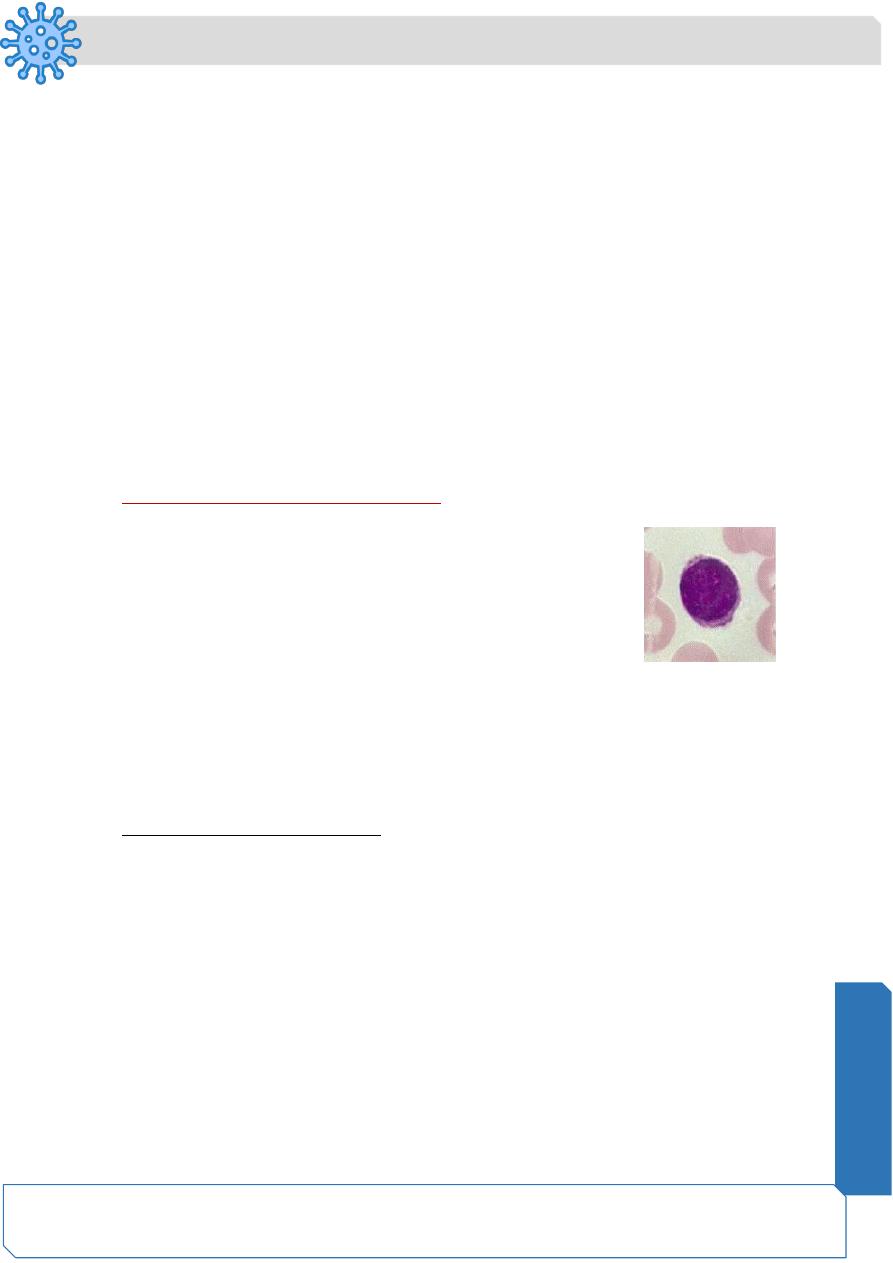
Microbiology
Notes…
8
Infection or tissue injury stimulates mast cells, basophils and other cells to release
vasodilators. Vasodilation results in increase capillary permeability
• If epith. lining is breached by microbes, resident phagocytes are attracted (influx)
to the site by chemotactic substances as bacterial endotoxins (LPS), serum C5a,
IL-8, and leukotriene B4.
• The macrophages produce cytokines as IL-1 & TNF.These activate endothelial cells
of nearby venules to produce adhesion molecules (selectin, integrins, & ICAM) and
chemkines (e.g.,IL-8) which mediate MIGRATION of leucocytes & monocytes from
the blood to tissues (diapedesis).
• The phagocytes have receptors on their surface through which they ATTACH non-
specifically to m.o. Examples: Receptors for bacterial endotoxines, for mannose
residues on glycoprotein of many bacteria, unmethylated bacterial DNA & double
stranded RNA of many viruses. The attachment and ingestion is enhanced if
microbes are coated with IgG or C3b (opsonization
5. Natural Killer (NK) cells( CD56+)
-
Large round granular lymphocytes
-
Always remain in the circulation
-
Act as immunological surveyors (cytotoxic cells)
Kill virally infected cells
Kill tumours
• However, NK cells do not require stimulation, nor they do exhibit memory cells.
NK cells respond in the absence of MHC proteins.
• What does CD refer to???????
CD (Cluster of Differentiation)
• CD
= Cluster of differentiation
• Leukocytes surface antigens that are expressed on cells of a particular lineage
“differentiation ”
• Also called CD molecules , CD antigens , CD markers
• Used to classify leukocytes into functionally distinct subpopulation ,e.g
• NK cells are CD56
+
• T - Lymphocytes CD3
+
(pan T cells marker)
• B - Lymphocytes CD19
+
• Monocytes / Macrophages CD14
+
